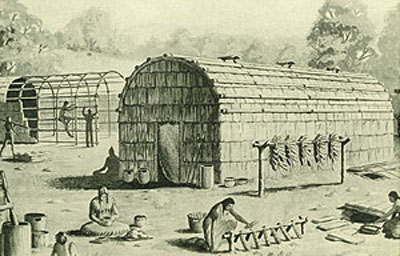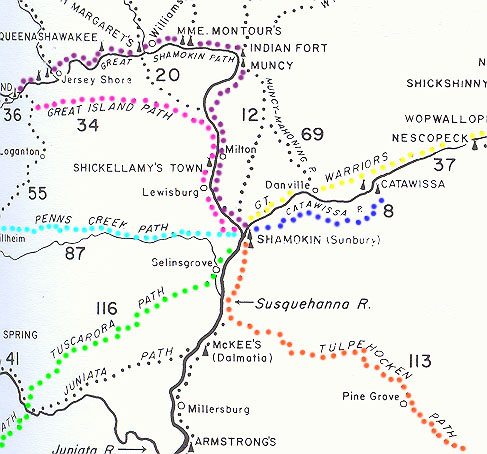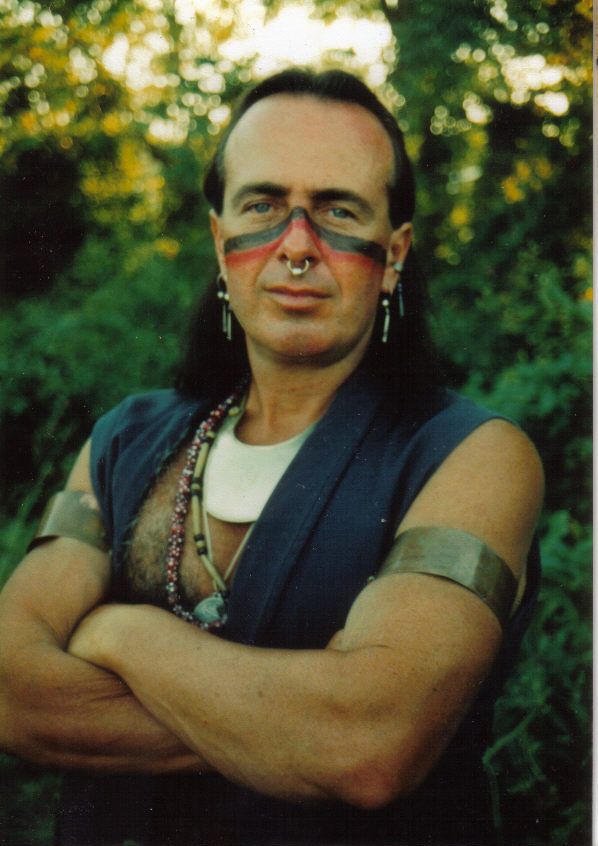A History
/SusquehannaRiver.jpg)

| Main Page |
| Time Line |
| History |
| Indian Trails and Shamokin (7000 BC-1763 AD) |
| Fort Augusta (1756-1792) |
| Founding of Sunbury (1772-1830) |
| Railroad and Canal Era (1830-1912) |
| Contemporary (1912-present) |
| Maps |
| Indian Trails and Shamokin (7000 BC-1763 AD) |
| Fort Augusta (1756-1792) |
| Founding of Sunbury (1772-1830) |
| Railroad and Canal Era (1830-1912) |
| Contemporary (1912-present) |
| Special Topics |
| Related Links |
| Works Cited |
Established in either 1142 or 1451, the Five Nations Iroquois confederacy consisted of the Mohawks, the Oneidas, the Onondagas, the Cayugas, and the Senecas. When the Tuscaroras joined in 1712 the union adapted the name Haudenosaunee, which translates to mean “six separate Indian nations”. In treaties and other colonial documents they were known as the “Six Nations.” While each tribe controlled its own domestic affairs, the council at Onondaga controlled matters that referred to the nation as a whole. Similarly, despite the fact that all spoke the same language, each tribe had a distinct dialect of its own. Thus not only did the Iroquois provide a strong government and military base to protect their farmland, they also formed one of the nation’s earliest and strongest diplomacies.
Though the Iroquois never specifically occupied any part of Pennsylvania, their southern conquests from their homes in New York and southern Canada established them as the ruling supremacy over all other Pennsylvanian tribes: the Andastes, the Lenni Lenape, the Shawanese, the Ganawese, the Conoys and others. As resident viceroy they appointed the great Indian ambassador, Shikellimy (see Shikellimy). |
. Tioga Point Museum, Athens, Pa |
Their military victories were due in a large part to their strong intertribal relationships with one another and to their association with European allies. The Dutch began to sell firearms to the Five Nations in 1640 and this new fire power enabled them to begin conquering neighboring tribes. The Onondaga chief, Canasatego often encouraged colonists to follow the Five Nations’ example. He urged creating union and friendship both internally, amongst themselves, and externally, between themselves and the Indians. He claimed that the unity established by the Five Nations and the good relations they’d formed with white explorers had made them "formidable" and had given them "great weight and authority" over people and lands (Everts and Stewart, 28). Due to their practice of adopting prisoners of war, any racial distinction between each tribe or between themselves and the Algonquins was virtually nonexistent. It was the strong sense of identity that was provided through wampum belts, ceremonial chants, daily customs, and oral historical tradition, that made the Iroquois unique.
In terms of spirituality the Iroquois practiced a religion of love. They believed that the Great Spirit Tarachiawagon, which literally means “Holder of the Heavens”, cared for his people and asked that they care for one another. Furthermore, Tarachiawagon had appointed to each of the Six Nations its own dwelling place, taught them how to use the corn and fruits of the earth, and could be approached by way of the woods.
Their religion also contributed to their deep sense of brotherhood. Social grades did not exist because the tribe shared everything. Leaders were respected, but considered equals with their lowest members. Words for “your highness”, “your majesty” and “your excellency”, were nonexistent; the English governor was called “Brother” and Shikellamy, the “great pro-council at Shamokin”, died in rags. This sense of brotherhood examplefies further that in their minds the true strength of the Iroquois was not exhibited through military victories, but rather through the large number of allies they had.
A further result of their love and respect was shown through their lack of crime. The Iroquois did not have police and they didn’t need them. Their code of honor was seldom broken because citizens feared public disapproval. Only two crimes were named, theft and murder, and both were punishable by death. Violence committed by drunken men was overlooked because rum was believed to have power that extended beyond human will. Conrad Weiser found that as long as “the rum trader is absent…one can be among them for thirty years or more and never once see two sober Indians fight or quarrel” (Wallace 21).
The Bucknell Environmental Center▪ 835 Fraternity Road ▪ Bucknell University ▪ Lewisburg ▪ PA 17837▪ (570) 577-1490


